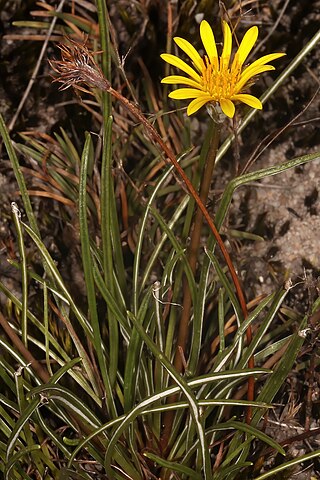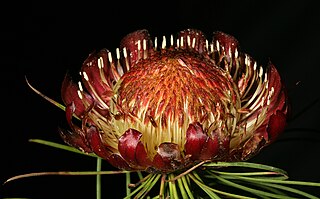
Gazania is a genus of flowering plants in the family Asteraceae, native to Southern Africa.

Gazania linearis is a species of flowering plant in the family Asteraceae, with thin linear leaves, native to South Africa.

Gazania rigens, sometimes called treasure flower, is a species of flowering plant in the family Asteraceae, native to coastal areas of southern Africa. It is naturalised elsewhere and is widely cultivated as an ornamental plant.

Gorteria is a genus of small annual herbaceous plants or shrubs, with 8 known species, that is assigned to the daisy family. Like in almost all Asteraceae, the individual flowers are 5-merous, small and clustered in typical heads, and are surrounded by an involucre, consisting of in this case several whorls of bracts, which are merged at their base. In Gorteria, the centre of the head is taken by relatively few bisexual and sometimes also male, yellow to orange disc florets, and is surrounded by one complete whorl of 5–14 infertile cream to dark orange ray florets, sometimes with a few ray florets nearer to the centre. None, some or all of them may have darker spots at their base. The fruits remain attached to their common base when ripe, and it is the entire head that breaks free from the plant. One or few seeds germinate inside the flower head which can be found at the foot of plants during their first year. The species flower between August and October, except for G. warmbadica that blooms mostly in May and June. The species of the genus Gorteria can be found in Namibia and South Africa.

Gazania krebsiana is is a species of flowering plant in family Asteraceae. It is a low-growing herbaceous perennial native to Southern Africa, ranging from Angola, Zambia, and Mozambique to South Africa. It is one of some 19 species of Gazania that are exclusively African and predominantly South African - only Gazania krebsiana subsp. serrulata (DC.) Roessler ventures northwards from the Transvaal into tropical Africa.

Brachylaena rotundata is an occasionally deciduous Southern African shrub or small tree growing to some 8m in height and of the family Asteraceae. It occurs in eastern Botswana, Transvaal, Mozambique, Zambia and Zimbabwe, growing in open woodland, on rocky koppies and slopes, and on stream banks. Kew accepts Brachylaena rotundata S. Moore as a species while 'Flora of Mozambique' treats it as a variety of Brachylaena discolor DC. It bears attractive foliage, green on the upper surface and silver-grey on the lower, leaves turning slightly reddish in autumn.
Leaves with petioles from 2 mm to 7 mm. long, lamina 4–15 x 2.5–6 cm., larger on coppice shoots, broadly oblanceolate or elliptic, obtuse to rounded at the apex, cuneate or rounded base, entire, occasionally coarsely dentate near the apex; upper surface araneous when young, or glabrescent; lower surface greyish tomentellous with prominent veins. Capitula sometimes preceding the leaves, young synflorescences with buds in axillary and terminal spikes, mature synflorescences with numerous capitula in dense terminal panicles 4–40 cm. long, or in short raceme-like panicles in axils of old leaves. Involucres cyathiform to obconic. Phyllaries minutely glandular outside, subobtuse, margins ciliolate, the outer phyllaries from c. 1 mm. long and ovate, the inner to c. 5 mm. long becoming lorate-lanceolate, narrowly obtuse or blunt at the apex; the outermost 5–8 series decreasing in size and extending down to the base of the capitulum stalk. Male flowers: corollas dull-yellow, 3–5 mm. long, lobes c. 1.5 mm. long and ± recurved; pappus uniseriate, setae 3–4 mm. long, subplumose, the seta barbs exceeding the seta axis in width. Female flowers: corollas dull-yellow, 3–5 mm. long, filiform, lobes erect up to c. 0.5 mm. long; achenes c. 4 mm. long, subcylindric-fusiform, narrowly c. 8-ribbed, pubescent; pappus 2-several-seriate, setae 4–5 mm. long, ± terete or flattened, seta barbs ± equalling the seta axis in width.""

Gorteria diffusa is a highly variable, small annual herbaceous plant or rarely a shrublet that is assigned to the daisy family. Like in almost all Asteraceae, the individual flowers are 5-merous, small and clustered in typical heads, and are surrounded by an involucre, consisting of in this case several whorls of bracts, which are merged at their base. In G. diffusa, the centre of the head is taken by relatively few male and bisexual yellow to orange disc florets, and is surrounded by one complete whorl of 5–14 infertile cream to dark orange ray florets, sometimes with a few ray florets nearer to the centre. None, some or all of them may have darker spots at their base. The fruits remain attached to their common base when ripe, and it is the entire head that breaks free from the plant. One or few seeds germinate inside the flower head which can be found at the foot of plants during their first year. The species flowers between August and October. It is called beetle daisy in English and katoog in Afrikaans. It can be found in Namibia and South Africa.

Felicia canaliculata is a grayish green shrublet in the family Asteraceae that grows up to 40 cm (16 in) in height. It has narrow, awl-shaped leaves, relatively large flower heads with approximately a dozen light purple to white ray florets encircling many yellow disc florets. It can only be found in the Western Cape province of South Africa.

Gazania lichtensteinii is a species of flowering plant in the family Asteraceae, native to South Africa and Namibia. On the SANBI Red List, it is listed as "safe".

Felicia tenella is an annual, sometimes biennial, herbaceous plant that may be slightly woody at its base, of 5–70 cm tall, that is assigned to the family Asteraceae. The species is very variable in size and hairiness. Its branches may be erect or ascending, and the leaves are narrowly line-shaped, 2–5 cm long and about 1 mm (0.04 in) wide. The leaves have a callous tip, lack visible nerves, and are mostly rigidly ciliate. The flower heads sit individually at the tip of stalks, have an involucre of three whorls of bracts, and about thirty light blue ray florets surrounding many yellow disc florets. Four subspecies are recognised. The species naturally occurs in the Northern Cape and Western Cape provinces of South Africa.

Protea pendula, also known as the nodding sugarbush or arid sugarbush, is a flowering plant of the genus Protea, in the family Proteaceae, which is only found growing in the wild in the Cape Region of South Africa. In the Afrikaans language it is known as knikkopsuikerbossie or ondersteboknopprotea.

Protea sulphurea, also known as the sulphur sugarbush, is a flowering plant of the genus Protea in the family Proteaceae, which is only known to grow in the wild in the Western Cape province of South Africa. A vernacular name for the plant in the Afrikaans language is heuningkoeksuikerbos or Skaamblom.

Protea pityphylla, also known as Ceres sugarbush or mountain rose, is a flowering shrub of the genus Protea, in the family Proteaceae. The plant is endemic to the southwestern Cape Region of South Africa.

Felicia is a genus of small shrubs, perennial or annual herbaceous plants, with 85 known species, that is assigned to the daisy family. Like in almost all Asteraceae, the individual flowers are 5-merous, small and clustered in typical heads, and which are surrounded by an involucre of, in this case between two and four whorls of, bracts. In Felicia, the centre of the head is taken by yellow, seldom whitish or blackish blue disc florets, and is almost always surrounded by one single whorl of mostly purple, sometimes blue, pink, white or yellow ligulate florets and rarely ligulate florets are absent. These florets sit on a common base and are not individually subtended by a bract. Most species occur in the Cape Floristic Region, which is most probably the area where the genus originates and had most of its development. Some species can be found in the eastern half of Africa up to Sudan and the south-western Arabian peninsula, while on the west coast species can be found from the Cape to Angola and one species having outposts on the Cameroon-Nigeria border and central Nigeria. Some species of Felicia are cultivated as ornamentals and several hybrids have been developed for that purpose.

Gazania heterochaeta is a species of flowering plant in the family Asteraceae, native to South Africa and Namibia.

Gazania ciliaris is a species of flowering plant in the family Asteraceae, native predominantly to the Western Cape province, South Africa, where it occurs from Vanrhynsdorp to the Eastern Cape near Joubertina.

Gazania rigida, the "Karoo Gazania", is a species of flower native to the Western Cape and Northern Cape Provinces of South Africa.

Gazania serrata is a species of flowering plant in the family Asteraceae, native to the Northern Cape and Western Cape provinces, South Africa.
Gazania maritima is a species of flowering plant in the family Asteraceae, native to the Western Cape province, South Africa.
Ursinia punctata is a species of plant belonging to the daisy family. It is found growing in South Africa, where it has a wide distribution.




















